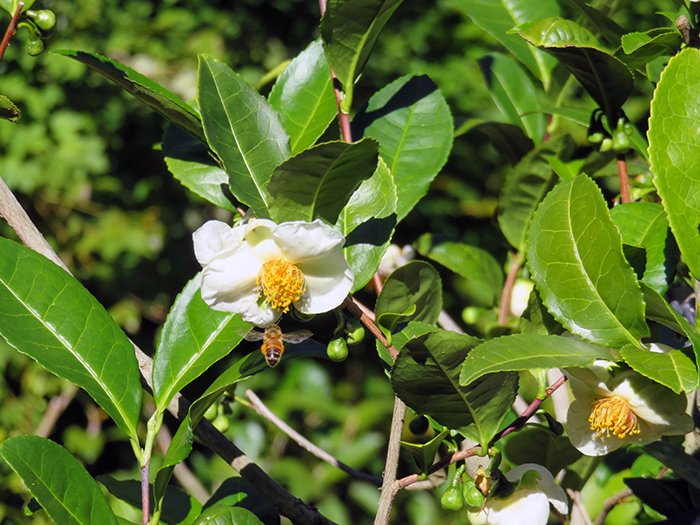Garden Talk
Horticultural Highlight: Tea camellia
In this series, the staff of Duke Gardens highlights plants you’ll find within our 55-acre living collection. This week, marketing and communications assistant Katherine Hale features the unexpected botanical source of one of the world's most popular beverages.
Botanical name: Camellia sinensis
Common name: Tea camellia
Family name: Theaceae (Tea Family)
Native range: China to India, Burma (Myanmar), Thailand and Vietnam
Location in Duke Gardens: Culberson Asiatic Arboretum
USDA Hardiness Zones: 6-9

The first question visitors to Duke Gardens usually have about the tea camellias are, “You can really grow those here?” Yes, you can! While the exact distribution of wild tea camellias in central Asia is uncertain, the plant is now widely grown across the tropics and subtropics of multiple continents, including right here in central North Carolina.
The other question visitors have once they see the plants are, “Wait, you mean the tea we drink comes from a camellia?” Once again, the answer is yes, so much so that the camellia family is also known as the Theaceae, or “tea family,” in Latin. If the thick glossy leaves and bushy growth weren’t proof enough of the relationship, a visit to the Culberson Asiatic Arboretum in late September and October will dispel any lingering doubts, as hundreds of tiny white camellia flowers bloom, drawing in humans and honeybees alike with their abundance and fragrance.
Like other camellias, tea plants are attractive evergreen shrubs or small trees. The beverage known as tea is made by steeping the dried young leaves of the tea camellia in hot water. In order to maximize the production of young shoots and leaves for harvest, tea plants are often grown in large plantations as low and dense hedges. The shrubs are pruned and shaped throughout the growing season to encourage both the health of the plant and flushes of new growth.
With the exception of herbal “teas” (more properly known as “tisanes”), which are composed of other species like hibiscus or mint, every kind of true tea has its origins in C. sinensis. However, the exact color and taste of the resulting beverage depends on how the leaves are harvested and processed. Green tea is made from freshly harvested young leaves and buds that are dried and steamed, and thus retain their original coloration, while oolong and black teas are made from older leaves that are oxidized under controlled conditions before they are dried.
The flavor of tea is also affected by the variations within the tea plants themselves; Assam tea (C. sinensis var. assamica) tastes different from the Chinese small-leaf tea (C. sinensis var. sinensis). Many kinds of specialty teas, such as Darjeeling, are made from hybrids of these two main groups. Then there is the terroir—“tea-roir,” if you will—the environmental factors and farming practices that shape the resulting flavor even further, with tea from shade-grown plants tasting different from those grown in full sun, and so on, along with the heat of the water and how long it is steeped for, and anything else that might be blended in for additional flavor (such as the bergamot oil in the famous Earl Grey black tea blend).
The Culberson Asiatic Arboretum has a small planting of tea shrubs in training for leaf production along the gravel road near the Lewis Street gate, featuring three different seed strains. The “Fairhope Select” strain (formerly known as "Lipton Plantation") is from Donnie Barrett in South Carolina, based on specimens from research plantings by the Lipton tea company, with small, heavily serrated leaves and an abundance of new growth. The "Sochi" strain has glossy, medium-sized leaves with a bushier form, and it hails from Sochi, a subtropical resort town on the Black Sea in southern Russia, while the "China" strain, as its name suggests, is a small-leaf form from China.
While tea camellias have four-season appeal, they are especially lovely in autumn when in bloom. Those interested in experiencing tea in a different way here at Duke Gardens might also consider signing up for one of the Japanese tea gatherings hosted in the Durham-Toyama Sister Cities Japanese Pavilion in the Asiatic Arboretum.
Photos from top: Close-up of tea camellia flowers in the Culberson Asiatic Arboretum by Lori Sullivan; the tea camellia garden, by Lori Sullivan; a camellia shrub in the garden, by Sue Lannon.






